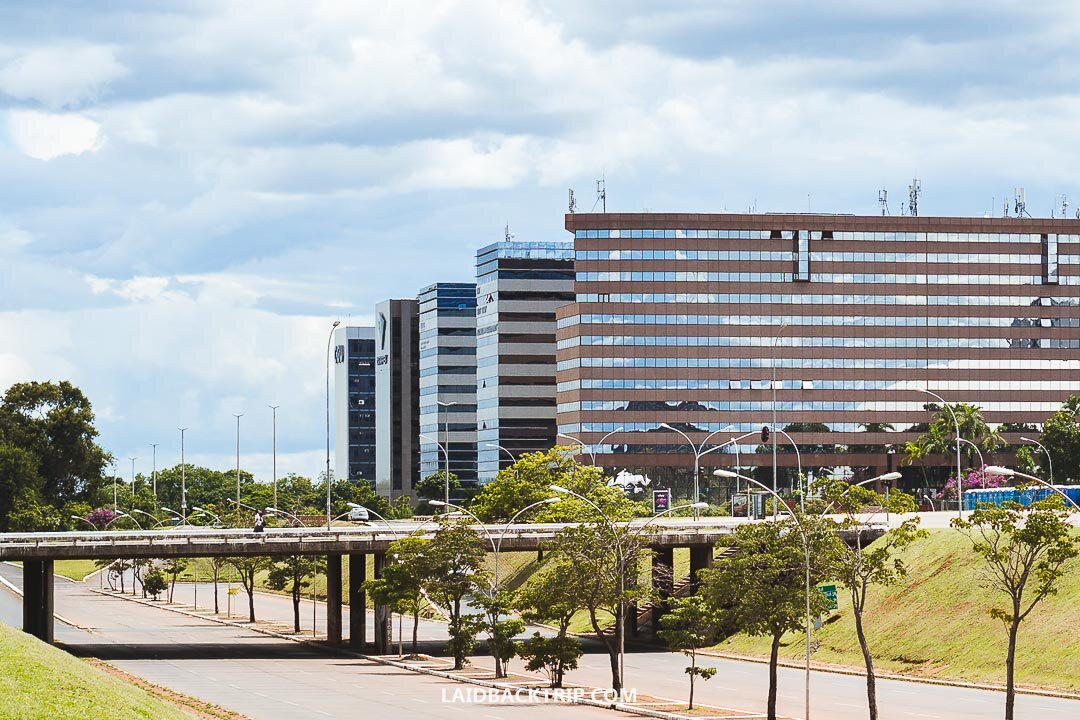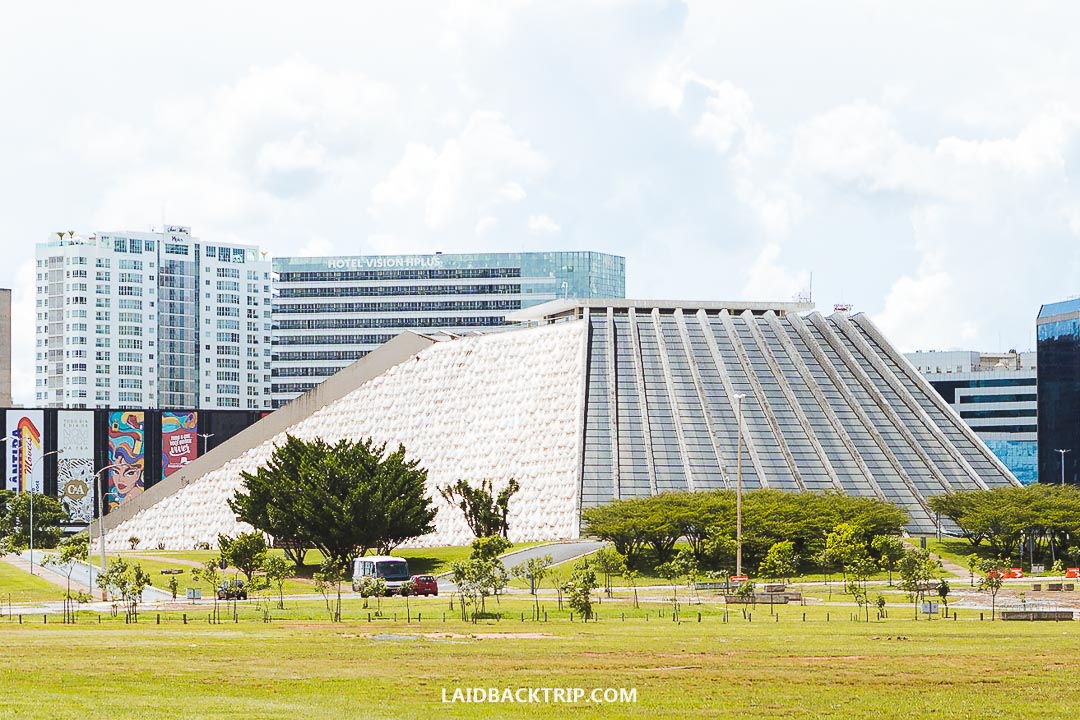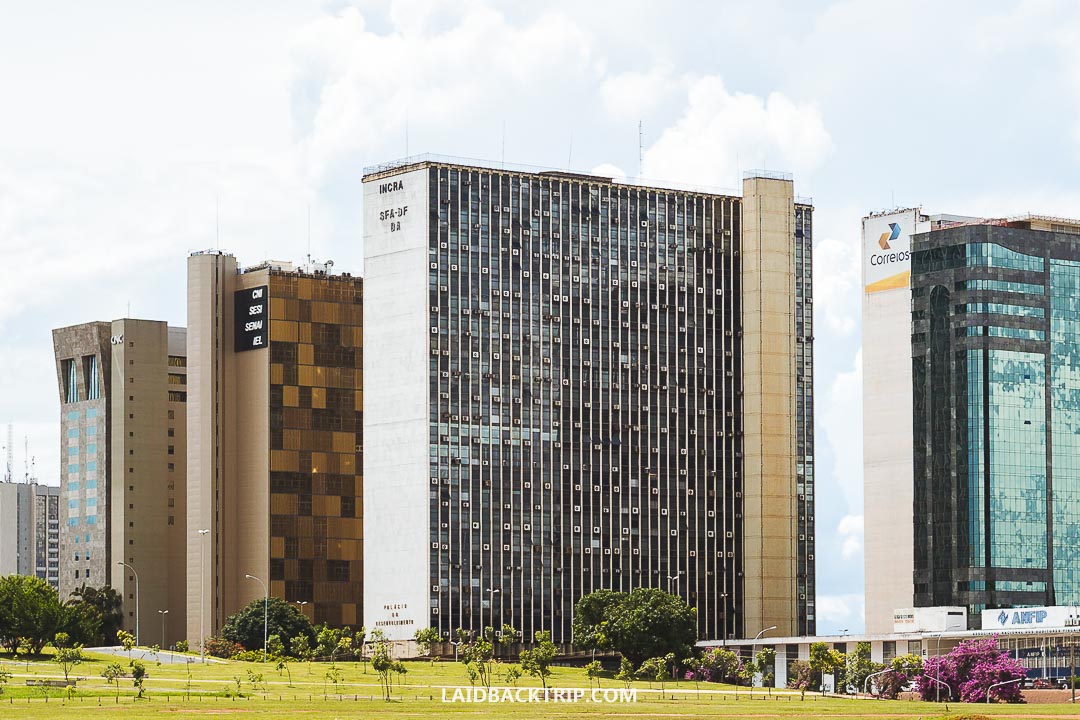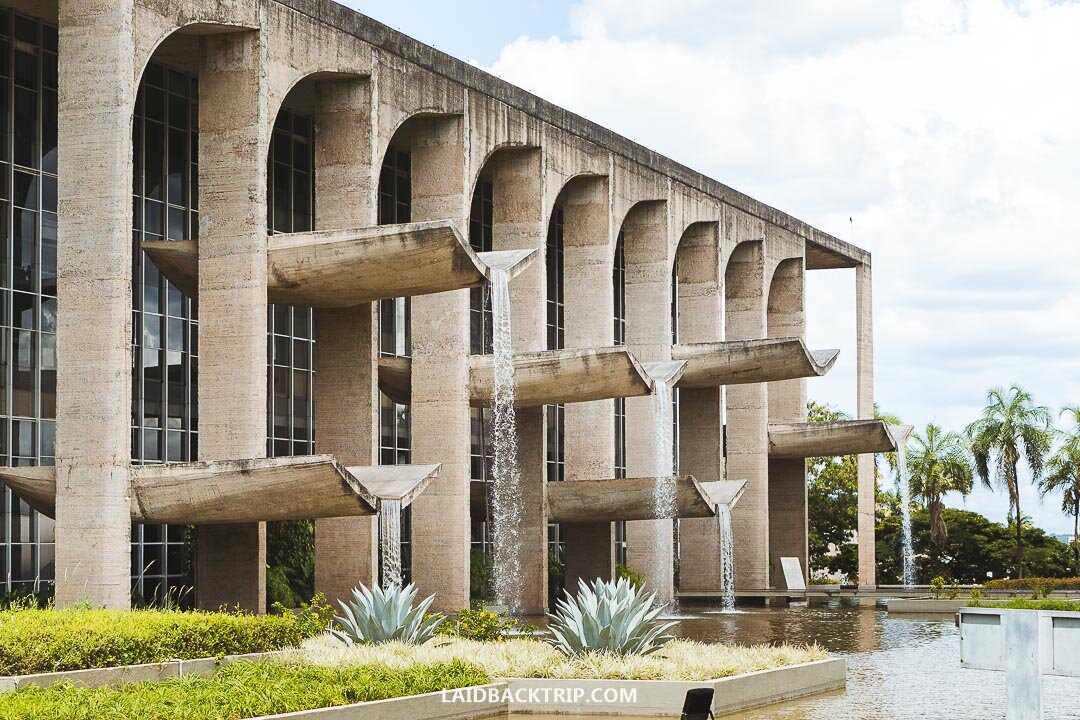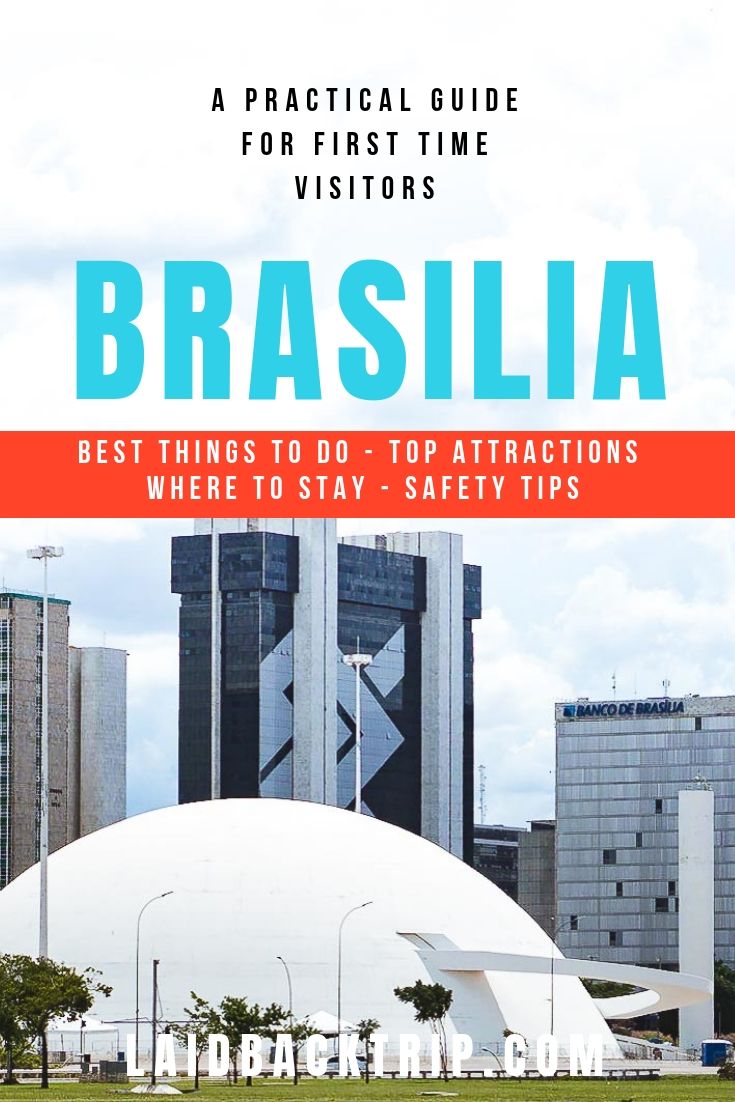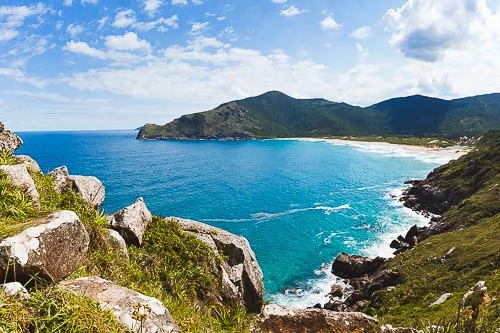Brasilia: A Practical Guide for First Time Visitors
Read our travel guide to Brasilia, the capital city of Brazil, including the best things to do, must-visit places, top attractions, where to stay, how to get around, and safety advice.
Brasilia is a utopia city, a city where every angle, every street, every building, and even the number of people which should have been living in the city and how many cars they should drive was carefully planned.
That cannot be said about our plans to travel to Brasilia, the capital city of Brazil, a country where we had been traveling for a month or so. One evening we were sitting in our room in Belo Horizonte and were trying to figure out our itinerary for the next few days.
We knew we can travel north to Salvador, but after that, we wanted to get to Panama, so we started to search for flight tickets, and the cheapest tickets we found were from Brasilia.
What was even better, the city of Brasilia was only one overnight journey away from us. So we booked the tickets, yet again changed our itinerary, and in two days we were standing on a bus terminal in Brasilia, without the tiniest idea what are the best things to do in the city and what we should see.
We went to the hotel, took a rest for a couple of hours, and meanwhile searched for terms such as what are the best things to do in Brasilia and how to explore Brasilia in one day.
When we finally set off, we knew where to go, that we can see most of the buildings in the city on foot, and that we should not be that worried about the safety situation in the city.
Brasilia will for sure never be the must-visit destination for foreign visitors.
It does not have the captivating atmosphere, beaches and the beautiful landscape such as Rio de Janeiro and it is not a melting pot of cultures such as Sao Paulo.
But if you have even a small possibility to fit the city on your Brazil itinerary, do it.
The modern futuristic architecture is absolutely outstanding. Exploring the streets of Brasilia is like walking in an outdoor museum of architecture and admiring an open exhibition of Brazil's most famous architect Oscar Niemeyer.
We spent only one day in Brasilia, but despite being short on time, we had enough time to see the best the city has to offer.
Here's our guide to Brasilia, including a brief history, best things to do in the city, safety advice, tips on where to stay, what to pack, and how to get around.
A BRIEF HISTORY OF BRASILIA
Before traveling to Brasilia, the capital city of Brazil, we had never seen such a carefully planned city before.
Although you can object that the USA or Australia have also many well-planned cities with a clear structure, we are not afraid to say that Brasilia is different.
First, the city was built from scratch in only three years with the simple purpose - to be the new capital of Brazil and connect the often overlooked western part of the country with the rest of Brazil.
And second, not only the streets are planned.
Every single building was designed to fit into the concept, and even now when the city is spreading, there are rules how the new parts of the city must look like.
The idea of building Brasilia was first said aloud in 1827.
And although there were some plans during the years and the place on the Brazilian Highlands was pre-selected as well as the name, nothing happened until 1955 when beloved Juscelino Kubitschek was elected president, and things were finally set in motion.
Designing Brasilia must have been a dream for all architects and urban planners (Lucio Costa was the chief planner) as there was a vast plain, and they could have a fresh start.
The scheme of the city looks from above like a cross or as an airplane, and there were precisely planned areas for the seat of government, for recreation, for living, or shopping.
The construction of the city started in 1956, and the city was officially completed in 1960 when government offices and ministeries were finally able to move in the city.
The motto of President Juscelino Kubitschek was "fifty years in five" as he wanted to make Brazil grow during his five years of leadership more than in the previous fifty years.
Brasilia became a symbol of economic power, and the fast construction should have given people faith, that everything is possible. Because everything in the newly built city was so carefully planned, many people say that Brasilia is lacking the soul.
Also, people living in the city now are descendants of people who came to build Brasilia, and later did not have money or energy to return, so they stayed, but don't feel the pride to be the citizens of Brasilia as they don't have their roots here.
Either way, for us, Brasilia was yet another impressive stop on our South America itinerary.
THINGS TO DO IN BRASILIA
Brasilia is not the classical tourist destination with plenty of things to see and do. Not at all.
We had a feeling that the only people visiting the capital city of Brazil are either locals (it is kind of a must to see your capital city at least once in a lifetime, right?), travelers who either fly in or out Brazil and architecture geeks who want to explore the city which is definitely interesting from this point of view.
To be honest, we were in the second group, and hadn't we found a cheap flight ticket from Brasilia to Panama, we most likely would not have stopped in the city either.
But as our flight was in the evening, we had a full day to explore Brasilia, and at the end of the day, we found the place interesting as it was completely different than any other city we have visited in South America.
Here are the best things you can see and do in Brasilia.
It is easy to explore Brasilia on own, but if you are short on time and want to see the most the city has to offer, you can take a guided tour.
Catedral Metropolitana Nossa Senhora Aparecida
As many buildings in the city, the Metropolitan Cathedral alias Cathedral of Brasilia was designed by Brazil's famous architect Oscar Niemeyer.
As Brasilia is a new modern city, you won't find here any old stone churches, and the main cathedral of the city is the example of what you can expect.
Clean lines, white color, and timeless design, this is what characterizes the cathedral.
Walk inside (the entrance is sort of underground) to fully appreciate the grandeur of this building which looks pretty small from the outside.
Esplanada dos Ministerios
Promenade of Ministeries is exactly what the name says. It is a complex of tall buildings which contains all the ministeries of the country.
Although the buildings are not somehow impressive, it is strange to know that this is the place where all the important decisions about the country's direction are being made.
Praca dos Tres Poderes
Three Powers Square is the plaza at the end of Promenade of Ministeries.
It is the place where you can find three impressive buildings which are the seats of Brazil's three highest authorities such as the National Congress, the Presidential Palace, and the Federal Supreme Court.
National Congress
Designed by Oscar Niemeyer, the National Congress is located in the most splendid building on the square: in two alike skyscrapers towering above two concave domes where sit members of Chamber of Deputies and Senate.
It is possible to take a free guided tour and explore how the building looks inside.
In case you want to have a tour in English, you need to reserve it in advance.
Unfortunately, we did not know it, so we had the tour in Portuguese, did not understand a word, but it was still interesting to see the interior of the most important building in Brazil.
We also got postcards here we could send anywhere in the world for free.
Palacio do Planalto
Presidential Palace, the official seat of the President of Brazil, is also possible to visit, on a guided tour only on weekends.
The architecture is again simple, and this is what makes it outstanding - curvy lines and water around the building which creates reflections.
Supremo Tribunal Federal
The Federal Court stands right opposite the Presidential Palace, and the building looks very similar, only outside the Federal Court is a statue of a sitting woman.
Palacio da Alvorada
The President's official luxury residence sits on a small peninsula on the shore of Paranoa lake, and it is off-limits for visitors.
Itamaraty Palace
One of the most beautiful architectural feats in Brasilia, Palácio dos Arcos alis The Palace of the Arches boasts with many symmetrical arches reflecting in the pool surrounding the building.
Santuario Dom Bosco
If you think this church is impressive from the outside, we would like to know what you would think about its interior.
This church is one of the most outstanding buildings you can find in Brasilia, and it is one of a few which was not designed by Oscar Niemeyer.
The church has ceiling-to-floor windows of blue-stained glass and it creates the effect of a star-lit sky.
Centro Cultural Banco do Brasil
The cultural center is yet another modern building, but if you have time, it is worth it to check out what is going on inside as the center hosts a different kind of exhibitions, concerts or festivals, and it is the cultural center in the true sense of the term.
You can find other centers like this one in other cities in Brazil, for example in Sao Paulo, Rio de Janeiro or Belo Horizonte.
READ MORE:
A Complete Guide To Visiting Iguazu Falls
Florianopolis Guide: Exploring Magical Island in Brazil
Visiting Christ the Redeemer, Brazil: Everything You Need to Know Before You Go
Sugarloaf Mountain Guide: The Best Attraction in Rio De Janeiro
Best Things to Do in Paraty, Brazil You Can't Miss
35 Fun Activities and Things To Do In Paraty, Brazil
Television Tower
Brasilia's Television Tower is hard to overlook as it is 224 meters high. It is possible to get to the observation deck for free.
The deck is 74 meters above ground, and from here you can get a better sense of how the city, at least its oldest part Plano Piloto, looks like.
At the base of the tower is a handicraft and food market, the official market day is Sunday.
Museum of Indigenous People
Yanomami is a group of indigenous people living in Brazil's and Venezuela's Amazon.
They usually build their houses in the round shape and when Oscar Niemeyer was designing the museum, he consulted the construction with the tribe to ensure authenticity.
Inside the museum are many indigenous arts and artifacts from many parts of Brazil.
Juscelino Kubitschek Memorial
Memorial JK is dedicated to Brazil’s former president, one of a very few politicians admired by Brazilians who are usually disgusted by their corrupted leaders.
Kubitschek was Brazil's president, who set the project of constructing the city of Brasilia into motion.
The monument is considered to be Niemeyer's finest work, and inside the building is a museum dedicated to Kubitschek's life and also mausoleum.
National Theater Claudio Santoro
The enormous theatre looks a bit like an inaccessible fortress, and yet again it shows how exceptional architect Niemeyer was.
The whole theatre complex contains three halls suitable for plays, concerts or different kinds of exhibitions, and it fits almost 1800 people.
Parque da Cidade
A large park Parque de Cidade is especially on weekends a popular retreat for the inhabitants of Brasilia.
If you want to take a break from all the white buildings and architecture, you can get lost in the park even for the full day.
To get to the park, you need to have own car, but there are quite many rental companies in Brasilia.
Parque Municipal do Itiquira
You can explore one of the highest waterfalls in Brazil in Parque Municipal do Itiquira.
Thanks to great infrastructure and easy access, this place is really popular among locals.
National Park of Brasilia
This is a peaceful place filled with fauna and flora where you can find many trekking trails, creeks, and pools. Its foundation is directly related to the foundation of the capital city, Brasilia.
Paranoa Lake
As everything else in Brasilia, Paranoa lake was planned. Its main purpose was to raise the humidity in an otherwise dry area of Brazilian Highlands.
Nowadays it's a popular place for leisure and free-time activities.
Poco Azul
If you have a car, you can drive about an hour from Brasilia to escape busy city life and explore several waterfalls.
Take a dip in refreshing blue waters or jump from the cliff.
SAFETY IN BRASILIA
It's not a secret that Brazil has a problem with violent crime, especially in bigger cities, but Brasilia has a good reputation when it comes to safety.
As always when traveling in South America, you should use your common sense, avoid poorly lit streets, not to walk outside after dark if it is not unavoidable, do not show off valuables and generally all the time be aware of your surroundings.
Like every city, Brasilia has a few sketchy areas on the outskirt of the city or around the bus terminal, but other than that, you should feel comfortable walking around.
In the past years Brasilia had a problem with carjacking, so when parking your car, always surveil your surroundings, and when driving, lock yourself in the car only as a precaution.
We’ve written an in-depth post How to Stay Safe in South America which you might find useful when planning on traveling to this continent.
Travel Insurance
We never leave home without travel insurance that was designed to cover our expenses if something goes wrong during the trip.
Travel insurance protects against theft, flight delays, injury, illness, cancellations, and much more.
World Nomads provides travel insurance for travelers to cover their trip essentials, including sports and adventure activities.
SafetyWing is affordable travel insurance for backpackers, long-term travelers, and digital nomads.
Travel smarter and safer!
HOW TO GET AROUND BRASILIA
Before we arrived in Brasilia, we had heard that public transport is quite good, there is Uber we can use, and it's simple to get around by car, but no one ever mentioned getting around the capital city of Brazil on foot.
Apparently, it has two reasons.
First, the safety situation is questionable in the city outskirts, and second, the city was not designed for pedestrians.
We arrived in Brasilia early in the morning from Belo Horizonte, where we had visited the outdoor Inhotim Museum and colonial town Ouro Preto, and took the metro to get near our hotel.
From the station we had to walk for about fifteen minutes, but we did not experience any troubles, and there was a pavement everywhere.
Later we walked from our hotel half an hour to the center, but again, we could not see why it is not recommended to explore the city of Brasilia on foot.
The streets were almost empty, there was a pavement so we did not have to walk on the road, and there was only one sketchy looking part around the local bus terminal.
Of course, getting around Brasilia by taxi is much easier and much comfortable than on foot.
However, when traveling on a budget and staying within walking distance to the city center, you can see the most of the landmarks on own (always use your common sense when it comes to safety).
When traveling outside the city or if you want to explore the outskirts, taking Uber is a good idea.
WHERE TO STAY IN BRASILIA
Brasilia is not the top tourist destination, but still, it is the capital city with many accommodation choices, especially business hotels.
The city does not have the typical center as it was built artificially, but it is quite easy to find here well-located hotels close to the main architectural sights and close to the metro.
We've handpicked three best hotels for every price category.
Budget | Sateltour Apart Hotel GY - Brasilia doesn't have many typical budget hostels, so this hotel is your best choice if you are looking for a relatively cheap price, good location, clean rooms, and outdoor pool.
Mid-range| Nobile Suites Monumental - Conveniently located hotel is well-equipped, rooms are spacious, rooms have a kitchenette, and guests can use the gym and pool.
Luxury | Cullinan Hplus Premium - The modern hotel offers air-conditioned rooms, tasty breakfast, gym, and rooftop pool.
Alternatively, search for your accommodation via Hostelworld.
HOW TO GET TO BRASILIA
Brazil is a large country, but when we do not count Amazon, the capital city of Brasilia is right in the middle, and all roads literally lead there.
Renting a car is a great idea if you want to have more freedom and fully explore Brazil independently.
When backpacking around Brazil, you must know that distances are vast, so be prepared to take overnight buses to get from one place to another to save time and money.
You can easily get to Brasilia from Sao Paulo, Rio de Janeiro, Salvador or as us, from Belo Horizonte.
Traveling overnight was pretty comfortable in Brazil, and we've never experienced a single issue.
Brasilia has an international airport which is quite close to the city center, and the easiest way how to get there is with Uber.
In the first place, we traveled to Brasilia because of our flight to Panama City which was cheaper than from other major cities, so it might be worth it when searching for flight tickets to check out connections to or from Brasilia as well.
WHAT TO PACK FOR BRASILIA
On average, you can experience hot weather in Brasilia all year round, but expect heavy torrential rains between November and March.
During this time the city should not be avoided, but you should pack accordingly.
Here are five essential things you should have in your backpack when traveling to Brasilia.
Moneybelt | As in any other large city in Brazil, it is better to keep your valuables safe.
Anti-Theft Daypack | Comfortable backpack is a must when walking around the city, on top of that this one has the safety feature.
Sunscreen | We spent in Brasilia one day during the dry season, and the sun was so strong, enhanced by the fact we were walking all day long in the concrete jungle. Do not forget to pack a quality sunscreen.
Short-Sleeved T-Shirt for Him & for Her | It can be so hot in Brasilia, that it is worth it to wear a functional t-shirt all day.
Umbrella | When visiting Brasilia during the wet season, an umbrella is a no brainer.
Travel Resources
Here you can find links to all the travel resources we use and which you might find helpful when planning your next holiday.
Accommodation: When looking for accommodation, we usually search hotels via Booking.com or Hostelworld.
Tours: Although we love to travel independently, some places are better to visit with a guided tour.
We prefer GetYourGuide for its easy-to-use interface and solid reputation. Another great alternative is Viator.
Rental Cars: When going on a road trip, we always use Rentalcars.com, a reliable site for booking a rental car in advance.
Flight Tickets: When looking for flight tickets, you can search Skyscanner to find the best price.
Travel Insurance: World Nomads and SafetyWing cover against risks of travel.


